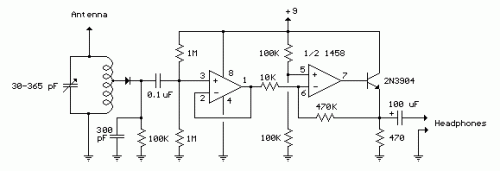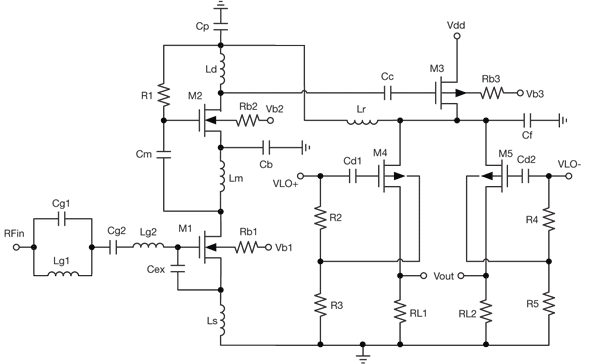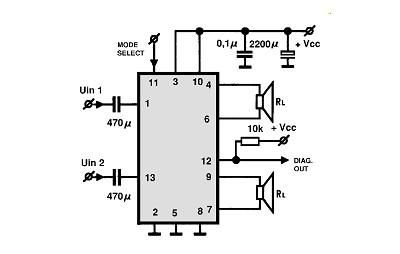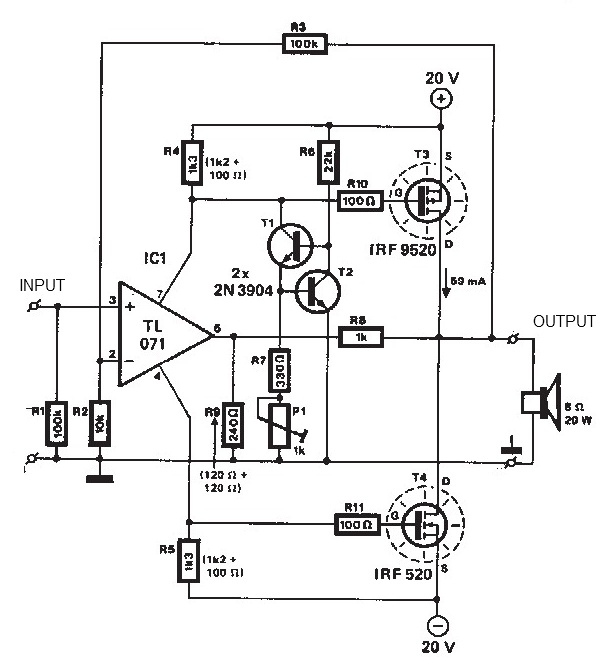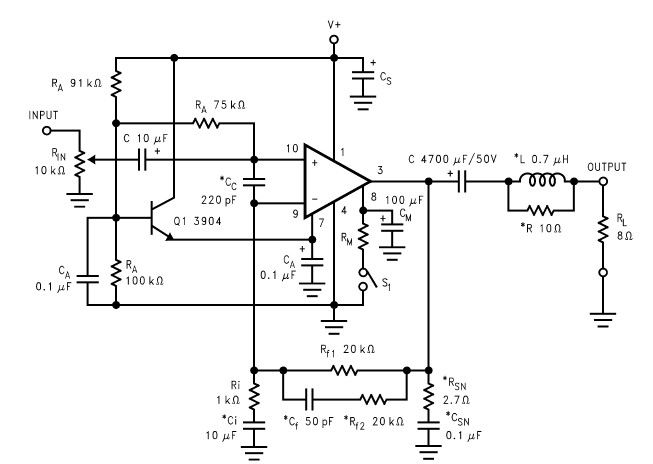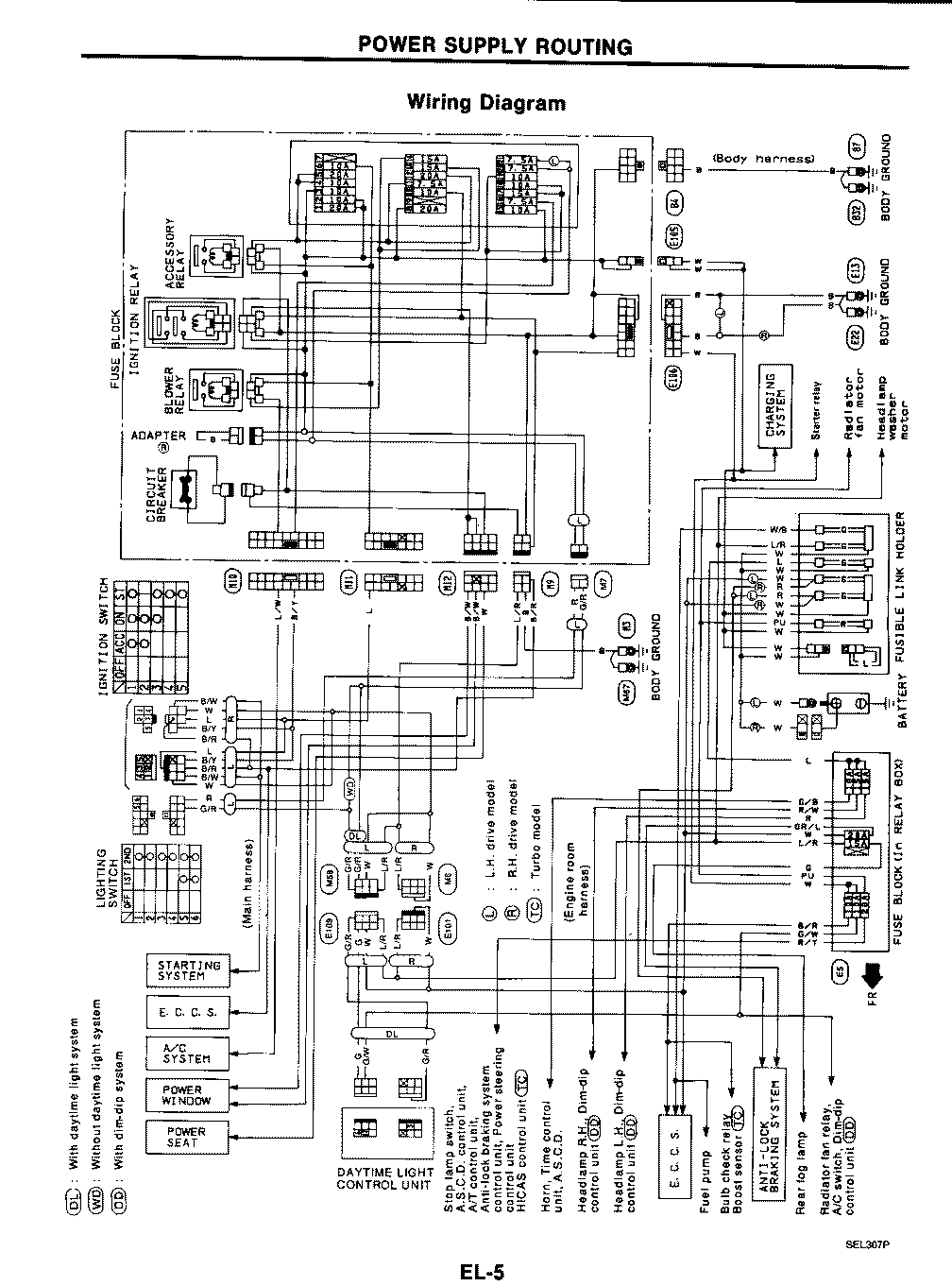
Updated 60-100W Hi-Fi Power Amplifier
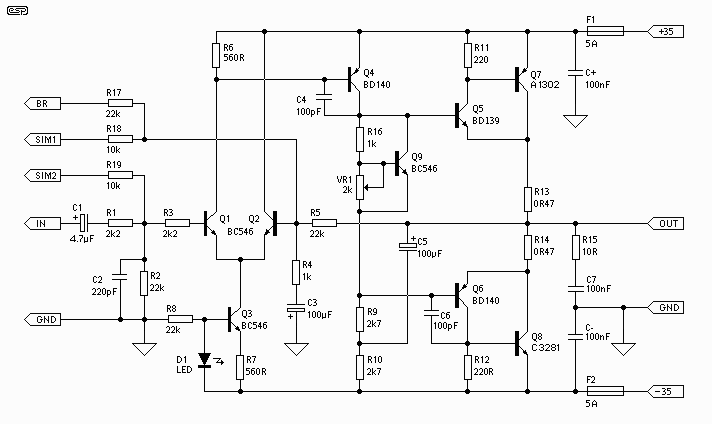
The foundation of this amplifier is detailed in Project 03, which does not claim to be cutting-edge; the base design is over 20 years old. It is straightforward to assemble, utilizes readily available components, and is stable and dependable. The presented design is a comprehensive update of the original project, maintaining many similarities while being fundamentally new. This amplifier, like its predecessor, is based on a design created years ago, with hundreds constructed. Most units functioned as small PA or instrument amplifiers, and many were also integrated into home hi-fi systems. The amplifier can drive loads as low as 4 Ohms, although this approaches the limits of the transistors; however, very few failures were reported at this impedance. Despite its simplicity, this amplifier delivers exceptional performance and should not be underestimated, as its sound quality is commendable, partly due to the design's inherent simplicity. The amplifier operates quietly and is reasonably tolerant of challenging loads, making it suitable for bi-amped systems. It can be operated in bridge mode (BTL) if the selected output transistors meet the necessary power ratings (e.g., MJ21193/4). Feedback from builders has been overwhelmingly positive, with the sound quality being among the best. It is important to note that, like the original design, there is no output short circuit protection; thus, shorting speaker leads while the amplifier is in operation poses a significant risk of damaging the transistors. The specifications closely mirror those of the original project, but the addition of a current sink in the differential pair input stage virtually eliminates turn-on and turn-off thump. The design includes an adjustable quiescent current feature, enabling the amplifier to provide 100W into 8 Ohms at a maximum supply voltage of +/-42V, easily sourced from a 30-0-30V transformer. While the design is not complex, it offers excellent performance. Connections for a Sound Impairment Monitor (SIM) are provided, along with a resistor (R17) for bridging. When bridging, the input should be grounded, and it is crucial to include the capacitor to prevent excessive DC offset. In bridge mode, the SIM should be connected only to the master amplifier. For operation into 4 Ohms (including bridging into 8 Ohm loads), the supply voltage should not exceed +/-35V (from a 25-0-25V transformer). Most applications will function well at lower voltages, ensuring reliability across various loads. In bridge mode, the amplifier can produce 200W into 8 Ohms reliably, even at continuous high power levels. Operating the amplifier in bridge mode with a 4 Ohm load is not advisable, as this would present an equivalent load of 2 Ohms to each amplifier, which it is not designed to handle and could lead to failure. D1 is a green LED, which should be a standard type; high-brightness LEDs or different colors should not be used due to variations in voltage drop. VR1 adjusts the quiescent current, typically around 100mA. While the amplifier operates at lower currents, distortion becomes noticeable below approximately 40mA. The Class-A driver (Q4) features a constant current load through the bootstrap circuit formed by R9, R10, and C5, with stability determined by C4, which should not be reduced. With fast output transistors like the specified 2SC3281 and 2SA1302, power bandwidth extends beyond 30kHz. With the recommended 35V supplies, Q4 and the output drivers (Q5 and Q6) generally do not require heatsinks. However, at 4 Ohm loads, heatsinking for Q5 and Q6 may be necessary, although they typically do not heat excessively under most conditions. Prior to powering the amplifier, it is essential to set VR1 to maximum resistance to minimize quiescent current, as a low resistance setting could result in excessive quiescent current, potentially damaging the output transistors. The use of available boards for this amplifier is recommended to facilitate construction. All resistors should be 1/4W 1% metal film for minimal noise, except for R9, R10, and R15, which should be 1W types, and R13 and R14, which must be 5W wirewound. The bootstrap capacitor (C5) should be rated for at least 35V, while other electrolytics can utilize any available voltage rating. The trimpot (VR1) is ideally a multiturn type, though a single-turn pot can be employed, albeit with more difficulty in setting the current and reduced reliability. A pair of these amplifiers can be adequately cooled with a 1°C/W heatsink for typical hi-fi applications; a fan may be advisable for high-demand use. It is vital to remember that there is no such thing as an oversized heatsink. The design is relatively new, and comprehensive measurements have yet to be conducted. The frequency response depends on the values of the input and feedback capacitors, and the specified values yield typical results. High-frequency response is determined by C4, which should remain unchanged. Operation with 4 Ohm loads is not recommended at 42V supplies due to peak dissipation exceeding 110W in each output transistor, leaving no safety margin with typical inductive loads. All supply voltages are specified at full power; the transformer may not maintain regulation, resulting in slightly lower power than indicated. The worst-case power for 8 Ohm loads is about 50W, but this requires a poorly regulated supply. Four of these amplifiers in a bi-amped configuration can achieve impressive sound pressure levels (SPL), similar to the setup being utilized. When combined with a Linkwitz-Riley crossover, the amplifiers can be positioned within the speaker enclosure, requiring only signal and power connections for a complete system that outperforms many commercial alternatives. If a dual-output bench power supply is unavailable, it is advisable to temporarily install 22 Ohm 5W wirewound safety resistors in place of the fuses before applying power. The load should not be connected during this initial power-up. Upon powering the unit, the DC voltage at the output should be verified to be less than 1V, and each supply rail should be measured, as they may differ slightly.The basis for this amplifier is published as Project 03, and makes no claim to be state of the art in fact the base design is now over 20 years old. It is a simple amp to build, uses commonly available parts and is stable and reliable. The design featured is a full update on the original project, and although it has many similarities, is re
ally a new design. This new amp (like the original) is based on an amp I originally designed many years ago, of which hundreds were built. Most were operated as small PA or instrument amps, but many also found their way into home hi-fi systems.
The amp is capable of driving 4 Ohms, but it is starting to push the limits of the transistors, however, even when used at 4 Ohms, very few failures were encountered. This amplifier, although very simple, is capable of superb performance. This is not an amp to be under estimated, as the sonics are very good indeed, and this is due (in part, at least) to the inherent simplicity of the design.
The amp is exceptionally quiet, and is reasonably tolerant of difficult loads. It is an ideal amplifier for biamped systems, and may be operated in bridge mode (BTL) if the selected output transistors have the necessary power ratings (e. g. MJ21193/4) I have heard nothing but praise from those who have built this amplifier the only feedback I have received has been very positive indeed.
The sound quality is up there with the very best. Highly recommended ! Note that like the original, there is (still) no output short circuit protection, so if speaker leads are shorted while the amp is working with a signal, there is a very real risk of the transistors being destroyed. The specifications are very similar to those of the original project, but the use of a current sink in the differential pair input stage means that there is virtually no thump at turn on or off.
I have also added the ability to adjust the quiescent current, and with the transistors specified the amp will provide 100W into 8 ohms, at a maximum supply voltage of +/-42V. This supply is easily obtained from a 30-0-30V transformer. As can be seen, it is not a complex amp, but the performance is excellent. Connections are provided for a SIM (Sound Impairment Monitor), and there is also a resistor (R17) added to allow bridging.
This resistor connects to the output of the other amplifier (the master). When used in this way, the input should be grounded do not omit the capacitor, or DC offset will be too high. When used in bridge mode (also called BTL Bridge Tied Load), the SIM should be taken from the master amplifier only.
For use into 4 ohms (including bridging into 8 ohm loads), do not exceed +/-35V (from a 25-0-25V transformer). Most applications will be satisfied with the lower voltage, and the reliability of the amp is assured with almost any load.
In bridge mode, this amp will happily produce 200W into 8 ohms, and will do so reliably even for continuous high power levels. Never attempt to operate the amp in bridge mode into 4 ohms, as this represents an equivalent load to each amp of 2 ohms.
The amp was not designed to handle this, and will fail. D1 is a green LED, and should be a standard type. Don`t use a high brightness LED, or change the colour. This is not for appearance (although the green LED looks pretty neat on the board), but for the voltage drop different coloured LEDs have a slightly different voltage drop. VR1 is used to set the quiescent current, and normally this will be about 100mA. The amp will work happily at lower current, but the distortion starts to be noticeable (on a distortion meter) at less than around 40mA.
The Class-A driver (Q4) has a constant current load by virtue of the bootstrap circuit R9, R10 and C5. Stability is determined by C4, and the value of this cap should not be reduced. With fast output transistors such as those specified (2SC3281 and 2SA1302), power bandwidth will be good to over 30kHz.
With the suggested and recommended 35V supplies, Q4 and the output drivers (Q5 and Q6) will normally not require a heatsink. With 4 ohm loads, you may find that a heatsink for Q5 and Q6 is needed, but my experience is that these transistors should not get hot under most operating conditions.
Before applying power, make sure that VR1 is set to maximum resistance to get minimum quiescent current. This is very important, as if set to minimum resistance, the quiescent current will be very high indeed (probably enough to blow the output transistors!).
Since I have boards available for this amp, I will obviously suggest that these be used, as it makes construction much easier. All resistors should be 1/4W 1% metal film for lowest noise, with the exception of R9, R10 and R15 which should be 1W types, and R13, R14 must be 5W wirewound.
The bootstrap capacitor (C5) needs to be rated at at least 35V, but the other electrolytics can be any voltage you have available. The trimpot (VR1) should ideally be a multiturn, but an ordinary single turn pot can be used. Setting the current will be a little more difficult with a single turn pot, and they are not as reliable.
A pair of these amps will be quite happy with a 1oC/W heatsink for normal hi-fi use. Consider using a fan if you are going to push the amp hard. Remember there is no such thing as a heatsink that is too big. The following is not comprehensive, since the design is quite new, and I have not had a chance to measure everything as yet. To give you an idea, this is what I have found so far The frequency response is dependent on the value for the input and feedback capacitors, and the above is typical of that when the specified values are used.
The high frequency response is fixed by C4, and this should not be changed. Operation into 4 ohm loads is not recommended with the 42V supplies. Peak dissipation will exceed 110W in each output transistor, leaving no safety margin with typical inductive loads. All supply voltages are at full power your transformer may not be capable of maintaining regulation, so power may be slightly less than shown.
This figure is typical, and is dependent on the regulation of the power supply (as in 2, above). Worst case power with 8 ohm loads is about 50W, but the supply needs to be fairly ratty for the power to drop this low. Four of these amps in a biamped arrangement will give you prodigious SPL, and is similar to the arrangement I am using.
Coupled with a Linkwitz-Riley crossover, the amplifiers can be mounted in the back of the speaker box, so only signal and power are needed for a complete system that will leave most commercial offerings for dead. If you do not have a dual output bench power supply Before power is first applied, temporarily install 22 Ohm 5 W wirewound safety resistors in place of the fuses.
Do not connect the load at this time! When power is applied, check that the DC voltage at the output is less than 1V, and measure each supply rail. They may be slightly different, ifier. 🔗 External reference
ally a new design. This new amp (like the original) is based on an amp I originally designed many years ago, of which hundreds were built. Most were operated as small PA or instrument amps, but many also found their way into home hi-fi systems.
The amp is capable of driving 4 Ohms, but it is starting to push the limits of the transistors, however, even when used at 4 Ohms, very few failures were encountered. This amplifier, although very simple, is capable of superb performance. This is not an amp to be under estimated, as the sonics are very good indeed, and this is due (in part, at least) to the inherent simplicity of the design.
The amp is exceptionally quiet, and is reasonably tolerant of difficult loads. It is an ideal amplifier for biamped systems, and may be operated in bridge mode (BTL) if the selected output transistors have the necessary power ratings (e. g. MJ21193/4) I have heard nothing but praise from those who have built this amplifier the only feedback I have received has been very positive indeed.
The sound quality is up there with the very best. Highly recommended ! Note that like the original, there is (still) no output short circuit protection, so if speaker leads are shorted while the amp is working with a signal, there is a very real risk of the transistors being destroyed. The specifications are very similar to those of the original project, but the use of a current sink in the differential pair input stage means that there is virtually no thump at turn on or off.
I have also added the ability to adjust the quiescent current, and with the transistors specified the amp will provide 100W into 8 ohms, at a maximum supply voltage of +/-42V. This supply is easily obtained from a 30-0-30V transformer. As can be seen, it is not a complex amp, but the performance is excellent. Connections are provided for a SIM (Sound Impairment Monitor), and there is also a resistor (R17) added to allow bridging.
This resistor connects to the output of the other amplifier (the master). When used in this way, the input should be grounded do not omit the capacitor, or DC offset will be too high. When used in bridge mode (also called BTL Bridge Tied Load), the SIM should be taken from the master amplifier only.
For use into 4 ohms (including bridging into 8 ohm loads), do not exceed +/-35V (from a 25-0-25V transformer). Most applications will be satisfied with the lower voltage, and the reliability of the amp is assured with almost any load.
In bridge mode, this amp will happily produce 200W into 8 ohms, and will do so reliably even for continuous high power levels. Never attempt to operate the amp in bridge mode into 4 ohms, as this represents an equivalent load to each amp of 2 ohms.
The amp was not designed to handle this, and will fail. D1 is a green LED, and should be a standard type. Don`t use a high brightness LED, or change the colour. This is not for appearance (although the green LED looks pretty neat on the board), but for the voltage drop different coloured LEDs have a slightly different voltage drop. VR1 is used to set the quiescent current, and normally this will be about 100mA. The amp will work happily at lower current, but the distortion starts to be noticeable (on a distortion meter) at less than around 40mA.
The Class-A driver (Q4) has a constant current load by virtue of the bootstrap circuit R9, R10 and C5. Stability is determined by C4, and the value of this cap should not be reduced. With fast output transistors such as those specified (2SC3281 and 2SA1302), power bandwidth will be good to over 30kHz.
With the suggested and recommended 35V supplies, Q4 and the output drivers (Q5 and Q6) will normally not require a heatsink. With 4 ohm loads, you may find that a heatsink for Q5 and Q6 is needed, but my experience is that these transistors should not get hot under most operating conditions.
Before applying power, make sure that VR1 is set to maximum resistance to get minimum quiescent current. This is very important, as if set to minimum resistance, the quiescent current will be very high indeed (probably enough to blow the output transistors!).
Since I have boards available for this amp, I will obviously suggest that these be used, as it makes construction much easier. All resistors should be 1/4W 1% metal film for lowest noise, with the exception of R9, R10 and R15 which should be 1W types, and R13, R14 must be 5W wirewound.
The bootstrap capacitor (C5) needs to be rated at at least 35V, but the other electrolytics can be any voltage you have available. The trimpot (VR1) should ideally be a multiturn, but an ordinary single turn pot can be used. Setting the current will be a little more difficult with a single turn pot, and they are not as reliable.
A pair of these amps will be quite happy with a 1oC/W heatsink for normal hi-fi use. Consider using a fan if you are going to push the amp hard. Remember there is no such thing as a heatsink that is too big. The following is not comprehensive, since the design is quite new, and I have not had a chance to measure everything as yet. To give you an idea, this is what I have found so far The frequency response is dependent on the value for the input and feedback capacitors, and the above is typical of that when the specified values are used.
The high frequency response is fixed by C4, and this should not be changed. Operation into 4 ohm loads is not recommended with the 42V supplies. Peak dissipation will exceed 110W in each output transistor, leaving no safety margin with typical inductive loads. All supply voltages are at full power your transformer may not be capable of maintaining regulation, so power may be slightly less than shown.
This figure is typical, and is dependent on the regulation of the power supply (as in 2, above). Worst case power with 8 ohm loads is about 50W, but the supply needs to be fairly ratty for the power to drop this low. Four of these amps in a biamped arrangement will give you prodigious SPL, and is similar to the arrangement I am using.
Coupled with a Linkwitz-Riley crossover, the amplifiers can be mounted in the back of the speaker box, so only signal and power are needed for a complete system that will leave most commercial offerings for dead. If you do not have a dual output bench power supply Before power is first applied, temporarily install 22 Ohm 5 W wirewound safety resistors in place of the fuses.
Do not connect the load at this time! When power is applied, check that the DC voltage at the output is less than 1V, and measure each supply rail. They may be slightly different, ifier. 🔗 External reference
